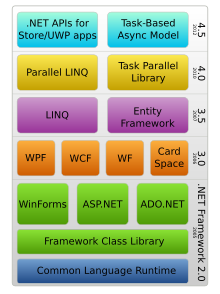
Back Microsoft .NET Framework Afrikaans دوت نت فريموورك Arabic .NET Framework Azerbaijani .NET Framework Byelorussian Microsoft .NET Framework Bulgarian .নেট ফ্রেমওয়ার্ক Bengali/Bangla .NET Framework BS Microsoft .NET Catalan .NET Czech .NET (Microsoft) Danish
 | |
 .NET Framework component stack | |
| Developer(s) | Microsoft |
|---|---|
| Initial release | February 13, 2002 |
| Stable release | 4.8.1
/ August 9, 2022[1] |
| Operating system | Windows 98 or later, Windows NT 4.0 or later |
| Platform | IA-32, x86-64, and ARM |
| Included with | Microsoft Windows |
| Successor | .NET |
| Type | Software framework |
| License | Mixed; see § Licensing |
| Website | dotnet |
The .NET Framework (pronounced as "dot net") is a proprietary software framework developed by Microsoft that runs primarily on Microsoft Windows. It was the predominant implementation of the Common Language Infrastructure (CLI) until being superseded by the cross-platform .NET project. It includes a large class library called Framework Class Library (FCL) and provides language interoperability (each language can use code written in other languages) across several programming languages. Programs written for .NET Framework execute in a software environment (in contrast to a hardware environment) named the Common Language Runtime (CLR). The CLR is an application virtual machine that provides services such as security, memory management, and exception handling. As such, computer code written using .NET Framework is called "managed code". FCL and CLR together constitute the .NET Framework.
FCL provides the user interface, data access, database connectivity, cryptography, web application development, numeric algorithms, and network communications. Programmers produce software by combining their source code with the .NET Framework and other libraries. The framework is intended to be used by most new applications created for the Windows platform. Microsoft also produces an integrated development environment for .NET software called Visual Studio.
.NET Framework began as proprietary software, although the firm worked to standardize the software stack almost immediately, even before its first release. Despite the standardization efforts, developers, mainly those in the free and open-source software communities, expressed their unease with the selected terms and the prospects of any free and open-source implementation, especially regarding software patents. Since then, Microsoft has changed .NET development to more closely follow a contemporary model of a community-developed software project, including issuing an update to its patent promising to address the concerns.[2]
In April 2019, Microsoft released .NET Framework 4.8, the last major version of the framework as a proprietary offering, followed by .NET Framework 4.8.1 in August 2022. Only monthly security and reliability bug fixes to that version have been released since then. No further changes to that version are planned. The .NET Framework will continue to be included with future releases of Windows and continue to receive security updates, with no plans to remove it as of September 2024.[3]
- ^ "Download .NET Framework 4.8 Offline Installer". Microsoft. Archived from the original on August 15, 2019. Retrieved August 15, 2019.
- ^ Ibanez, Luis (November 19, 2014). "Microsoft gets on board with open source". Opensource.com. Archived from the original on January 2, 2020. Retrieved January 2, 2020.
- ^ gewarren. ".NET Framework & Windows OS versions". Microsoft Learn. Archived from the original on September 3, 2022. Retrieved November 21, 2020.